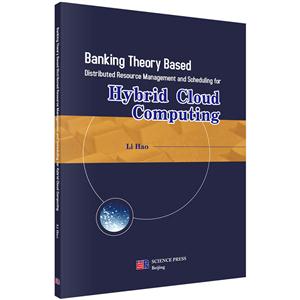1 Cloud Computing Resource Management and Scheduling Based on a Banking Model 1.1 Introduction 1.2 Inspiration for Computational Clouds 1.3 Banking Model Based Cloud Computing Resource Management and Scheduling 1.3.1 The Cloud Computing Requirements Analysis 1.3.2 The Technical Cloud Environment Requirement 1.4 Contributions to Research 1.4.1 Banking Model for Cloud Computing Resource Management 1.4.2 Optimal Deposit-loan Ratio 1.4.3 Risk Mitigation and Prediction Management 1.4.4 Pricing Scheme of the Cloud Resource over the Lifecycle 1.4.5 Cloud Computing Resource Management and Distribution Based on the Pareto Equilibrium 1.4.6 Building a Real Cloud Computing Platform Based on Open Sourcing 1.5 Organization References2 Background Study on Cloud Computing, Resource Management and Scheduling 2.1 Computational Clouds 2.2 The Evolution of Cloud Computing Technology 2.2.1 Parallel Computation 2.2.2 Distributed Computing 2.2.3 The Main Difference between Distributed Computing and Parallel Computing 2.2.4 Grid Computing 2.3 Cloud Computing 2.3.1 Background Research 2.3.2 The Definition of Cloud Computing 2.3.3 The Taxonomy of Cloud Computing 2.3.4 Internal Components of Cloud Computing 2.3.5 Main Differences between Cloud Computing and Grid Computing 2.4 Cloud Resource Management 2.4.1 Main Strategies of Cloud Resource Management 2.4.2 The Taxonomy of Cloud Resource Management 2.4.3 Key Cloud Resource Management Technology 2.5 Summary References3 Economics and Cloud Computing Resource Management 3.1 Survey of Economic Theories Based on the Grid Resource Management Project 3.2 Economic Theories can Provide a Solution to Solve Cloud Computing Resource Management Issues 3.2.1 Cloud Computing as a Business-driven Technology 3.2.2 Cloud Computing Technology Fit in with the Needs of the Society and Economic Laws 3.3 Using Economic Theories in Cloud Computing Resource Management 3.3.1 The Law of Demand and Supply in Cloud Computing Environment 3.3.2 The Law of Diminishing Marginal Returns in the Cloud Computing Environment 3.3.3 Monopolies in the Cloud Computing Environment 3.4 Summary References4 Problem Identification 4.1 Resource Accounting 4.2 Resource Scheduling 4.3 Cloud Computing Resource Transaction Risk Mitigation and Coping 4.4 The QoS Issue References5 Research Approaches to Banking Models for Cloud Computing Resource Management 5.1 Banking Model 5.2 How Does the Cloud Computing Follow the Real Bank to Do Transaction 5.2.1 Optimal Deposit-loan Ratio Theory in Cloud Banks 5.2.2 Identifying Factors Affecting the Cloud Bank 5.3 The Pricing Schema for Cloud Computing 5.4 Avoiding Banking Risk in the Transaction 5.5 Cloud Bank Scheduling and the Pareto Optimality 5.6 Interior Components of the Cloud Bank 5.7 Summary References6 Research Approaches for Risk Mitigation and Coping 6.1 The Risk Mitigation and Management in Commercial Banks 6.2 The Risk Mitigation in the Cloud Bank 6.2.1 The Classification of Risks in Cloud Bank 6.2.2 The Strategy of Risk Mitigation 6.2.3 The Strategy of the Risk Coping 6.3 Experiment Setup 6.4 Analysis of Experimental Results 6.5 Summary References7 Research Approaches for the Pricing Scheme of the Cloud Bank in the Price lifecycle 7.1 The Centralized Synchronous Algorithm 7.1.1 The Theory of Optimal Deposit-loan Algorithm 7.1.2 The Resource Management Model Based on Optimal Depositloan Algorithm 7.1.3 Single Resource Pricing Underlying the Cloud Bank Model 7.1.4 About the Optimal Deposit-loan Algorithm 7.2 Distributed Price Adjustment Algorithm 7.2.1 Pricing Scheme of Cloud Resources in the Initial Stage 7.2.2 Pricing Scheme of Cloud Resources in a Stable Stage 7.3 The Service Level Agreement of the Cloud Bank Model 7.3.1 Why We Need CBSLA 7.3.2 The CBSLA Framework 7.3.3 Signature Process of the CBSLA Contract 7.3.4 Generation of the CBSLA 7.4 Summary References8 Research Approaches for the Pareto Optimality Based Scheduling 8.1 The Concept of Pareto Optimality 8.1.1 Pareto Optimality 8.1.2 Pareto Improvement 8.2 Cloud Banks Achieve Optimal Resources Allocation by Pareto Theory 8.3 The Extended Pareto Optimality Model 8.3.1 Relative Proof 8.3.2 To Solve the Problem Under M x N Pareto Optimality 8.4 Cloud Banks Achieve Optimal Resources Allocation by Pareto Optimality Theory 8.5 Improvement of PO-based Allocation Strategy 8.6 The Steps of Dynamic Simulation 8.7 The Simulation Environment Set Up 8.8 Running the CloudSim Instance 8.9 Analysis of Experimental Results 8.10 Summary References9 The Real Laboratory Platform: IaaS Based Cloud Computing Platform 9.1 Introduction 9.2 Setting up the IaaS Based Cloud Computing Environment 9.2.1 The Comparison of the Two Kinds of the Platform Structures 9.2.2 Introduction of EUCALYPTUS 9.2.3 EUCALYPTUS Platform Advantage 9.2.4 EUCALYPTUS Platform Framework 9.2.5 EUCALYPTUS Components 9.2.6 EUCALYPTUS Configuration 9.2.7 EUCALYPTUS Installation Readiness 9.2.8 Installation of EUCALYPTUS Technical Route 9.2.9 Specific Methods of EUCALYPTUS Installation 9.3 Cloud Computing Simulator: CloudSim in Use 9.4 The Structure of the CloudSim 9.5 Summary References10 Conclusions and Future Directions 10.1 Summary 10.2 Conclusions 10.3 Future Directions 10.3.1 Supporting Accounting and Visualization 10.3.2 Supporting Complex Service and Task Description 10.3.3 Supporting Real Cloud Computing Environment Experiment Platform 10.3.4 Supporting a Variety of Risks in a Cloud Computing Environment

















